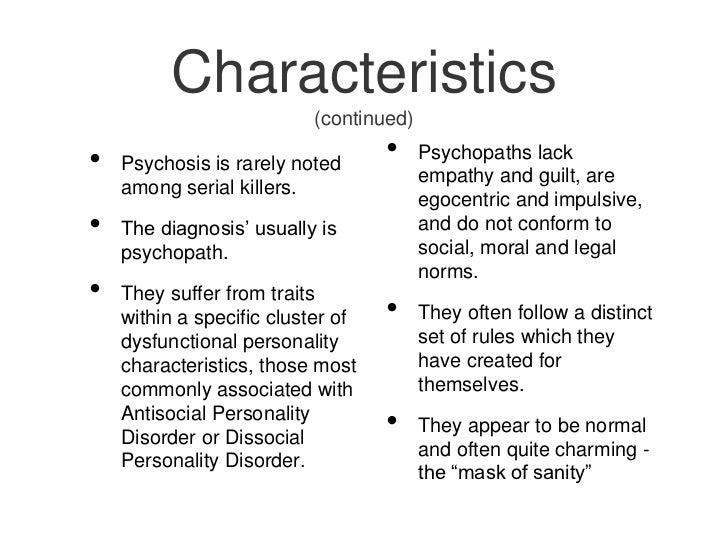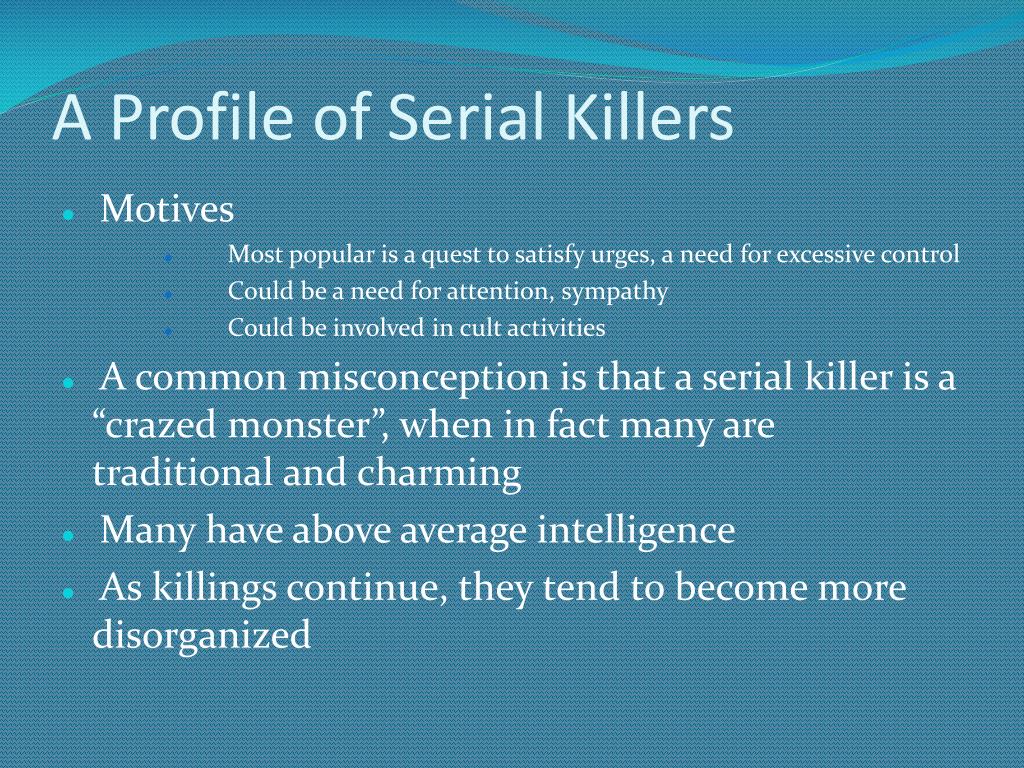Visionary Serial Killer Examples
Jan 26, 2015 David Berkowitz, the 'Son of Sam,' is frequently cited as a classic example of the visionary serial killer. They sometimes believe they are another person, or they are compelled to murder by higher entities such as God or the Devil. What are visionary killers? So-called visionary killers commit murder at the command of imagined internal or external voices which they experience and perceive to be real. Such individuals are often suffering from either psychoses or some other form of mental illness. Was Leigh Allen the Zodiac killer? Arthur Leigh Allen WASN’T The Zodiac Killer Just. Visionary killers select absolutely random victims; they don’t have any logical order or agenda of their killings because they’re driven to kill by the internal or external voice they imagine. They don’t have a specific victim type unless the voice or visual hallucination mandates it.

'Son of Sam' serial killer, went on a shooting spree that lasted a year and left 6 people dead and 7 wounded Visionary serial killers suffer from psychotic breaks with reality, sometimes believing they are another person or are compelled to murder by entities such as the Devil or God.
Every state has a different definition of what classifies as murder, homicide, serial murder, etc. The following is a brief overview of the broad definitions of serial murder and mass murder.
Serial Killer Classifications
Guttmacher (1973)
sadistic serial murderers are those who derive sexual gratification from killing and who often establish a pattern, such as the manner in which they kill or the types of victims they select. They are motivated by fantasies and the offender appears to derive pleasure from dehumanizing his or her victims.
Lunde (1976)

Difference between serial and mass murderer
Mass killers appear to suffer from psychosis and should be considered insane. Found little evidence of mental illness among serial killers.
Danto (1982)
Most serial murderers can be described as obsessive-compulsive because they normally kill according to a particular style and pattern
Egger (1984)
“Serial murder occurs when one or more individuals… commits a second murder and/or subsequent murder; is relationshipless (victim and attacker are strangers); occurs at a different time and has no connection to the initial (and subsequent) murder; and is frequently committed in a different geographic location. Further, the motive is generally not for material gain but is usually a compulsive act specifically for gratification based on fantasies. The key element is that the series of murders do not share in the events surrounding one another. Victims share in common characteristics of what are perceived to be prestigeless, powerless, and/or lower socioeconomic groups (that is, vagrants, prostitutes, migrant workers, homosexuals, missing children, and single and often elderly women)” (Hickey, 2010, p. 26).
Holmes and DeBurger (1988)
Visionary Type
such murderers kill in response to the commands of voices or visions usually emanating from the forces of good or evil. These offenders are often believed to be suffering from some form of psychosis.

Mission-Oriented Type
these offenders believe it is their mission in life to rid the community or society of certain groups of people. Some killers may target the elderly, whereas others may seek out prostitutes, children or a particular racial/ethnic group.
Hedonistic Type
offenders are usually stereotypes as thrill seekers, those who derive some form of satisfaction from the murders. Subcategories include those who kill for “creature comforts,” “pleasure of life,” and “lust murderers”
Power/Control-Oriented Type
the primary source of pleasure is not sexual, but is the killer’s ability to control and exert power over his helpless victim. Some offenders enjoy watching their victims cower, cringe, and beg for mercy.
Title 18, US Code, Chapter 51, Section 1111
Federal law passed by Congress: Protection of Children from Sexual Predator Act of 1998
“The term ‘serial killings’ means a series of three or more killings not less than one of which was committed in the United States, having common characteristics such as to suggest a reasonable possibility that the crimes were committed by the same actor or actors” (Hickey, 2010, p. 27).
Federal Bureau of Investigation’s Behavioral Analysis Unit at the National Center for the Analysis of Violent Crime symposium, San Antonio, TX (2006)
150 experts in the fields of psychiatry, forensic psychology, law, criminal investigation, and behavioral analysis gathered to define serial murder
Serial murder was defined as one or more offenders, two or more murdered victims, the killings should be occurring in separate events at different times, and the time period between murders separates serial murder from mass murder.
the unlawful killing of two or more victims by the same offenders in separate events
Mass Murderer Classifications
Wille (1974)
10 different types of murderers based on bio-socio-psychological categories
Depressive, Psychotic, Afflicted with organic brain disorder, Psychopathic, Passive aggressive, Alcoholic, Hysterical, Juvenile, Mentally retarded, and Sex killers.
Lee (1988)
created labels to differentiate between motives
Profit, Passion, Hatred, Power or domination, Revenge, Opportunism, Fear, Contract killing, Desperation, Compassion, and Ritual killers
Holmes and Holmes (2000)
Family Slayer or Annihilator
a person who kills his family and commits suicide
Murderer for Profit
a person who kills in order to profit materially. Murderers for profit may kill their family or other groups of people such as coworkers or friends.
Mission Oriented Serial Killer Examples
Murderer for Sex
a person with the primary goal to sexually torture, rape, and murder the victims.
Pseudo-Commando
a person with an obsession for guns and a fantasy for murder.
Set and Run Killer
a person who plans an escape route following the killing aftermath.
Psychotic Killer
a person suffering from acute or chronic psychosis who is considered to be legally insane
Disgruntled Employee

a person who seeks revenge for real or imagined wrongs at the hands of coworkers or employers.
Disciple-Type Killer
a person who commits murder at the behest of a charismatic leader
Ideological Mass Murderer
a person, especially a cult leader, who is able to persuade other to kill themselves or each other.
Institutional Mass Murderer
a person who commits mass murder as a crime of obedience when ordered to by his or her leader
References:
Athens, L. H. (1980). Violent criminal acts and actors. Cambridge, MA: Routledge and Kegan Paul.
Boar, R. & Blundell, N. (1983). The world’s most infamous murders. New York: Simon ans Schuster.
Egger, S. A. (2001). The killers among us: An examination of serial murder and its investigation. Upper Saddle River, NJ: Prentice-Hall.
Federal Bureau of Investigation. (2010). Serial murder: Multi-disciplinary perspectives for investigators. Retrieved from http://www.fbi.gov/stats-services/publications/serial-murder/serial-murder-1/
Hickey, E. W. (2010) Serial murderers and their victims. Belmont, CA: Wadsworth.
Warwick, A. (2006). The scene of the crime: Inventing the serial killer. Social & Legal Studies, 15(4), 552-569. Retrieved from http://web.ebscohost.com.ezproxy.umw.edu:2048/ehost/detail?vid=1&hid=104&sid=f92df02a-4f90-4904-b819-ac022eac3253%40sessionmgr104&bdata=JnNpdGU9ZWhvc3QtbGl2ZQ%3d%3d#db=a9h&AN=23637990
What Is A Visionary Serial Killer
Presented by: Ashley DuVal